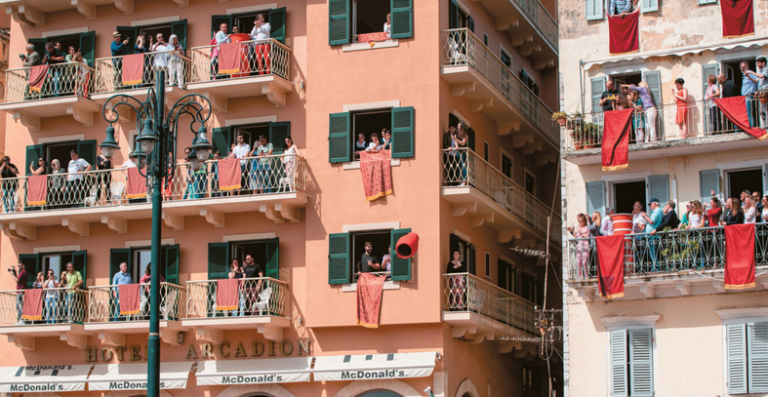Easter with satisfactory occupancy rates in mainland Greece, but also with travel movement both from Greece and abroad to the islands – for those hotels that have opened the curtain of the summer season – since this year the festive period coincides for both Orthodox and Catholics.
This is also one of the main reasons why the famous “Easter in the village” is being overturned, not of course by Greeks, who will once again follow the road to the countryside, but by foreign visitors who are expected in greater numbers in the large urban centers of the country. The top spot belongs to Athens, which is experiencing an extended tourism “spring” and is in any case going through the phase of establishing itself as a short city break destination for Europeans, while more foreigners are also expected this year in Thessaloniki, which is also gradually increasing its connectivity with direct flights from abroad. Following, although at a distance, is Heraklion in Crete, which has begun to rise as an urban destination with more hotels within the city and is also expected to receive a greater number of foreign visitors during the festive period, due to more direct connections with abroad and the Catholic Easter holidays.
Likewise, Greeks are also preparing to travel abroad, with travel agencies (Federation of Hellenic Associations of Travel & Tourist Agencies – FedHATTA) noting, especially in organized trips, a slight decline in bookings compared to the corresponding period last year, while still expecting last-minute bookings. However, in terms of destinations, it is interesting that beyond the “traditional” European countries, trips outside Europe are becoming increasingly popular, to both closer and more distant destinations: From Cairo as a cheaper option under 700 euros for a 6-day trip, to China and New York, where a 10-day “package” on the other side of the Atlantic is priced slightly below 1,700 euros, while a ten-day trip to Cuba costs close to 1,500 euros.
Briefly, around Greece, in Corfu – the most popular destination during this period, which is flooded with Greek visitors due to the famous Corfiot Easter – the numbers are as high as last year, and the same applies to other islands with local customs, such as Chios. In the major island destinations, in Crete, the number of visitors will indeed be higher, though not the hotel occupancies, due to both the larger number of accommodations that opened earlier this year and the competition from short-term rentals, while in Santorini the movement is expected to be clearly reduced. In mainland Greece, Magnesia, Volos, and Pelion are among the winners this year with satisfactory numbers from both Greece and abroad, with road tourists expected from Bulgaria and Serbia. In the Peloponnese, the increase is also reflected in the numbers of short-term rentals for closer destinations to Athens during the days from Holy Thursday to Easter Monday.
The numbers
A key feature, therefore, of this year’s holiday season has to do with the fact that Orthodox and Catholic Easter coincide, something that seems to give further momentum to the country’s major urban destinations due to increased connectivity with abroad and the launch of several new routes by airlines as part of their summer programs. Athens is the biggest winner and is expected to attract an even larger number of foreign visitors during the Easter period. As Eugenios Vassilikos, president of the Athens-Attica & Argosaronic Hotel Association, characteristically notes to “business stories,” “Because this year Orthodox and Catholic Easter coincide, we will have more foreign visitors and won’t see the major lull in the city,” as usually happens due to Athenians escaping to the countryside. In any case, the capital, having reached the record of 7,900,000 foreign visitors in 2024, continues its positive streak of increased visitation into 2025 as well, according to data from “Eleftherios Venizelos.” Already, for the first quarter of 2025, the traffic (arrivals, departures – domestic and international) at Athens International Airport reached 5,810,000 passengers, marking an 11.4% increase, with an impressive +15% in international traffic, reaching 4,200,000 visitors.
Thessaloniki
Likewise, Thessaloniki, which has also increased its connectivity with abroad this year, has higher expectations especially for this period through the “Worship Week” initiative, offering the public an atmosphere of devotion and preparation leading up to Holy Week, as well as the Holy Week services with the meeting of the five Epitaphs at Aristotelous Square. The promotional campaign has run in countries such as Romania, Bulgaria, Serbia, and North Macedonia, as the co-capital attracts a large number of visitors from the Balkans who also arrive by road. Hence, from the side of the Hotel Association, there is an expectation for good occupancy levels in the city’s accommodations, similar to last year’s, at around 75%. It is worth noting that at Thessaloniki Airport in April, the increase in offered airline seats on inbound international flights is in double digits, at +11.6%, exceeding 263,000, based on data from the Institute of the Greek Tourism Confederation (INSETE).
Other destinations
In Corfu, a destination that traditionally holds first place at Easter, demand is forming at the very high levels of last year during this period, at the start of the season, with expectations for summer being even higher. According to the estimates of the island’s tourism bodies, the number of travelers, both Greek and foreign, who will visit the top Ionian destination this Easter is expected to be just under 55,000. “Easter in Corfu is a reference point for both Greek and international tourism. This year’s Easter coincides with the Catholic one, which creates increased interest from abroad,” according to Spyros Chalikopoulos, Deputy Mayor of Tourism, Sustainable Tourism Development and Public Relations of the Municipality of Central Corfu and Diapontian Islands.
In the major Aegean destinations, especially Crete, considering that demand for the summer season had already shown early positive signs, and with the added fact that Catholic and Orthodox Easter coincide this year, more hotels have opened for the Easter period compared to previous years. “About 25% of all accommodations, including several resorts, have opened,” said Nikos Chalkiadakis, president of the Heraklion Hotel Association. “For this reason, although the number of visitors this Easter may indeed be higher, hotel occupancy in April is not that great and we estimate it will average around 35%-40% for the month. We expect better figures later on. Overall, we estimate that this year will be a good season for the island, with airline seat capacity showing a slight increase of 2%-3%, considering that Heraklion Airport has already reached its limits.”
In Rhodes, where the first charter flights from abroad have already started since the end of March, the coincidence of the two Easters makes the season’s start more dynamic for the destination, which has managed to bring forward the arrival of foreign visitors, effectively implementing an extension of the summer season both at its beginning and end. Notably, this April, Rhodes Airport has a 6% increase in offered airline seats from abroad, reaching 176,000 for the month.
The Cyclades
Santorini is a special case this year, following the phenomenon of intense seismic activity earlier, particularly in February. The island has returned to normal life, but as expected, tourist traffic is moving at significantly lower rates. As a result, many hotels on the island have postponed their opening to May or later and remain closed to make up time for preparing for the summer season.
On another island recently affected by weather events, Paros declares itself “fully ready” for Easter after the complete restoration of damages which, according to the municipality, were not as extensive as presented. In this case too, most hotels have not yet opened, waiting for May when the number of bookings is higher. According to current data, despite the negative publicity caused by the flooding, there have been no cancellations.
Mainland Greece
In Halkidiki, according to the president of the local Hotel Association, Grigoris Tasios, the vast majority of hotels will remain closed for Easter, given that the period immediately following the holidays has very low occupancy. The season will begin later, from May onward—depending on each hotel’s contracts—directly for the summer period. “Out of 500 hotels, only 30 will open for Easter, welcoming visitors from Greece and the Balkans who want to spend the holiday in our country.”
In Magnesia, “which is anyway a favorite Easter destination,” according to the president of the local Hotel Association, Giorgos Zafeiris, “occupancy levels are admittedly good, with an average booking rate of 75%-80%, and we believe there will be last-minute reservations, while we also expect visitors from the Balkans in the area.”
In the Peloponnese, for those seasonal hotels that do open—considering there’s a prolonged period of low activity between Easter and the height of the summer season—occupancy levels, according to Konstantinos Marinakos, president of the Peloponnese Tourism Organization, reach 60%-65% and are expected to rise further with last-minute bookings for the period from Holy Thursday through Easter Monday.
Aegean Airlines: Occupancies up to 85%
The increased traffic at airports for both Greece and abroad this Easter, compared to last year, is also reflected in the data from the country’s largest airline. Seat occupancy on AEGEAN flights ranges from 75%-85%, or even higher on some domestic routes with heavy traffic—for example, to Thessaloniki, with over 90%. The major travel days are Holy Thursday and Holy Friday, while the return is more spread out, both on Easter Monday and the weekend of April 26-27, as some travelers extend their holiday until schools reopen.
As for the most popular international destinations, from Athens they include Paris, Lisbon, Izmir, Malta, Berlin, and Dubrovnik; and from Thessaloniki: Barcelona, Amsterdam, Larnaca, Düsseldorf, and Zurich.
For domestic flights, popular destinations from Athens include Ioannina, Samos, Santorini, Rhodes, and Kos; and from Thessaloniki: Naxos, Kos, Chios, Mytilene, and Heraklion.
Ask me anything
Explore related questions





